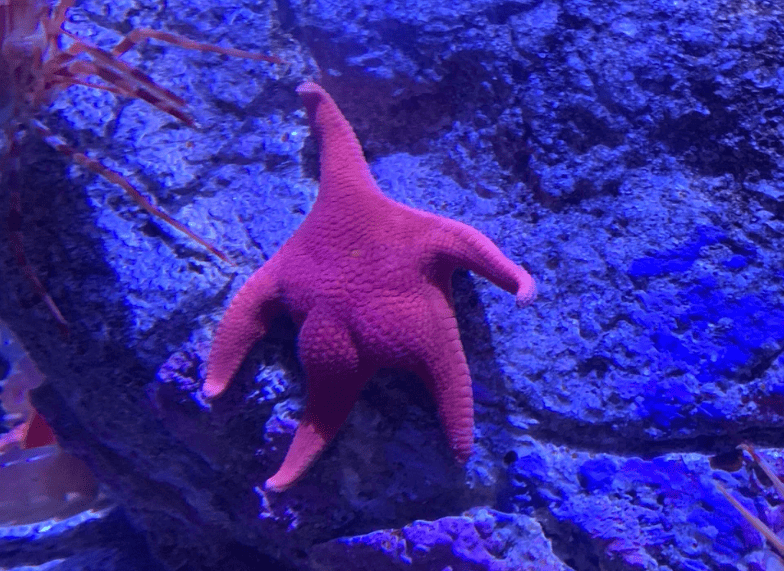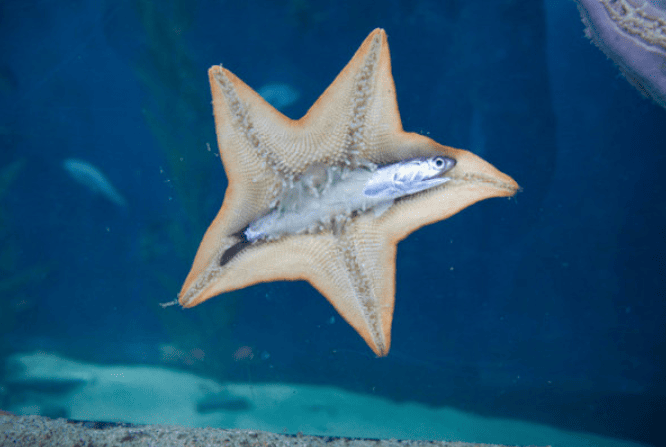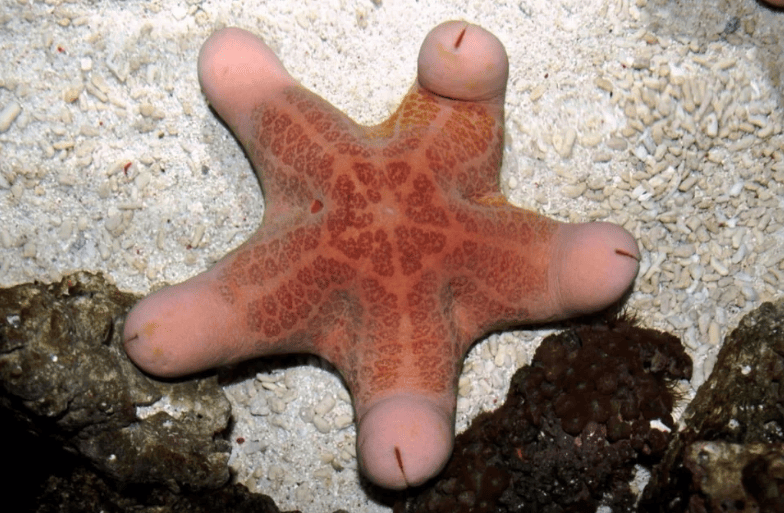Kept for their aesthetic appeal and as a part of the cleanup crew, starfish are saltwater invertebrates exhibiting a wide range of sizes, colors, and adaptations. With over 2000 known species, there is no shortage of them in aquariums. But, what do Starfish eat?

They inhibit habitats such as coral reefs, seagrass beds, and rocky shores in shallow coastal areas and deep ocean depths. Their radial symmetry and typical five arms make them aesthetic enough to be showcased in private and public aquariums.
Let’s discuss their diet in greater detail.
Table of Contents
What do Starfish eat?
Being carnivorous, starfish feed on crustaceans and mollusks in their natural habitat. Conditionally, they also try to prey on small fish. However, due to their slow movement and reliance on water flow for preying, they seldom succeed in that.
Their feeding mechanism revolves around the tube feet. Equipped with suction cups, it helps starfish pry open brittle shells and grip onto them. For the gruesome part, they evert their stomach into the prey’s body cavity to digest the food externally before absorbing it back. This allows them to consume prey much larger than their body.
Most starfish species are opportunistic predators, meaning that they feed on a range of available prey that’s available at that moment. Their adaptive feeding practices empower them to survive on most marine landscapes. They’ve even been observed to eat other starfish.

While most starfish species are generalists, some of them are specialist feeders. They typically don’t have a wide range of dietary preferences and favor specific organisms like coral polyps or snails. Herbivorous starfish species can also be observed in nature.
Apart from these, many other adaptations are prevalent in various starfish species. However, let’s limit our discussion to natural starfish food sources.
Bivalves and Mollusks
While they propel pretty fast, starfish are generally slow predators. So, being equally slow, bivalves and mollusks make the best prey for them. Bivalves include clams, mussels, oysters, and scallops, while mollusks include snails and other gastropods.
As mentioned, starfish use their tube feet to pry open the outer shells and externally digest their internal soft tissue to harvest protein and other nutrients.
However, while bivalves and mollusks are common prey for starfish, some species are more efficient to pry open and feed on bivalve shells.
Crustaceans
Crustaceans, such as crabs and shrimps, also are commonly consumed by starfish as a part of their natural diet. They hold and pump water, using tube feet, to propel faster to their prey and grab them with the suckers.
Being flexible in nature, the tube feet are able to conform to the shape of the prey, allowing a more effective hunt. For stronger crustaceans, starfish use their arm flexibility to wrap around and immobilize their prey.
Employing a similar mechanism, crustaceans also are externally digested and absorbed. Starfish praying on crustaceans also keep their population in check.
Small Fish
Most starfish species, except a few, don’t find it worthwhile to hunt fish for nutrients. Among them, Crown-of-Thorns Starfish, known to consume corals, were reported to prey on small fish.
Another species of starfish, called the Sand Star, also have been observed to wait in the depths of the sand and prey on unsuspecting fish.
Different starfish species employ different adaptations to catch live fish. While some of them rely on the tube feet to grab onto, others wait for the right opportunity to extend their arms and wrap around the prey.
Coral-Dwelling starfish have developed specific adaptations to navigate the coral to prey on the small fish inhibiting the reefs.
Detritus and Organic Matter
Detritus, marine waste lying on the ocean floor, provides an easy and sustainable source of nutrients for starfish. While starfish are predominantly known to feed on live prey, some species of them adapted to sift through sediments or collect organic particles.
Some starfish, relying on their modified tube feet and feeding structures, feed on decaying animals and plants. Moreover, as their mouth is located under their body where all the limbs meet, scavenging is a particularly effective method to feed for some bottom-dwelling starfish species.
While doing so, they participate in the marine nutrient recycling ecosystem by breaking down and decomposing organic matter.
Starfish Food and Diet

In artificial waters, such as saltwater aquariums and ponds, starfish adapt to a different domesticated diet provided by hobbyists like us. While some hobbyists add live crabs, snails, or shellfish to the aquarium to emulate a more natural habitat, some adaptations don’t work in confined environments.
For example, tube feet for locomotion are inefficient on the relatively smooth surface of aquariums. The absence of coarse surfaces and rocks makes it challenging to use tube feet for navigation.
Some starfish, for instance, use camouflage and coloration to prey and stay safe. In a controlled environment, these adaptations aren’t as useful and are unnecessary. Their propelling mechanism with tube feet may also be limited by the lack of space provided.
In this section, we’ll discuss a few diet options that are suitable for starfish living in your aquarium.
Frozen Food
Starfish frozen food typically is a combination of ingredients replicating their natural needs and usually includes various marine invertebrates, such as shrimps, mussels, krill, and other small creatures.
As the only source of food, frozen food also includes essential vitamins, minerals, and other nutrients to support the growth and well-being of your starfish. They also offer great convenience. They usually come in small cubes for precise and easy feeding.
When feeding frozen food, always thaw the food before offering it to the starfish. Thawing may involve using aquarium water to defrost the portions required before placing it near the starfish for it to locate and consume.
Moreover, try to offer different diets to your starfish to supplement the lack of other nutrients widely found in their natural habitat.
Check out our recent article on ‘Saltwater Vs. Freshwater Aquarium‘.
Live Food
A major issue with feeding live food to starfish is to avoid contamination and illness. Captive-bred crustaceans often carry diseases unknown to the starfish that may bring demise to your favorite starfish.
If kept well, live food introduces both balance and natural instinct to starfish. However, do consider the natural diet of your starfish species before introducing live food to your aquarium.
Moreover, don’t release them at once. Maintain a reasonable cycle of feeding and resting to prevent overfeeding and water quality issues. A few live food options for your starfish aquarium are:
- Bivalves
- Crustaceans
- Snails
- Worms
Before making live feeding regular, observe your starfish’s feeding behavior and adjust the frequency and quantity accordingly.
Pellets and Flakes
Pellets and flakes are commercially available formulated food sources for marine creatures. Typically made with particular species in mind, find pellets and flakes suitable for your starfish. As a diet, pellets and flakes are pretty well-balanced and often contain protein and other necessary nutrients.
Consider pellet and flake sizes before offering them to your starfish. If the pellets are bigger than the starfish’s mouth, they may have trouble consuming it. Moreover, do verify the composition of the particular product to fit your starfish and its preferences.
It’s important to make pellets and flakes readily available. Use forceps to place the pellets in the path of your starfish so that it can discover and consume them.
Seaweed and Algae
Not every species of starfish is an herbivore and readily consumes seaweed and algae. It’s important to understand the requirements of your particular species to offer them a well-balanced diet.
Specialized holders, feeding clips, and weighted clips can be used to hold seaweed and algae in place. Ensure that your starfish can easily access it. Moreover, do rotate between the algae and seaweed species to maintain variety and nutrient balance.
Don’t limit your starfish to a herbivorous diet, even if they enjoy it. Depending on the species, introduce frozen food and pellets to the diet to supplement the lack of protein and other nutrients.
A few different types of seaweed and algae available are:
- Nori Sheets
- Dried Seaweed
- Algae Sheets
As mentioned, observe your starfish to adjust the frequency and quantity of the servings.
To Read the complete care guide on ‘Swordtail Fish’ click here.
FAQs
Baby starfish, aka larvae, are planktonic, meaning that they feed on phytoplankton and zooplankton while drifting in the water. They employ their ability to filter feed through cilia to collect and consume food from the open water. As they grow, their dietary habits change and are replaced by more protein-rich sources.
Typically, starfish food and carnivorous fish food aren’t made similarly and may lack the nutrients necessary for your starfish. Always check product labels to ensure that the commercially available foods are suitable.
Given proper diet, nutrition, and environment, most common starfish live for 5 to 10 years, while a range of other starfish species, although rare, can live for more than 15 years.
The Bottom Line
We’ve tried to give you a detailed overview of what starfish eat through this comprehensive article. While most general information is covered, the diets and food choices may differ from species to species. Make sure to do proper research before introducing any sort of food to your starfish aquarium.
